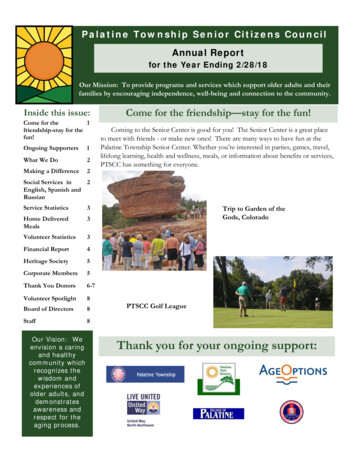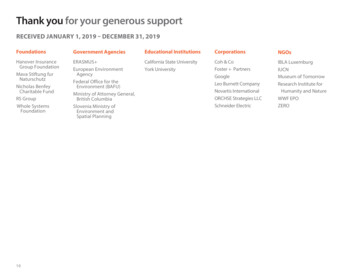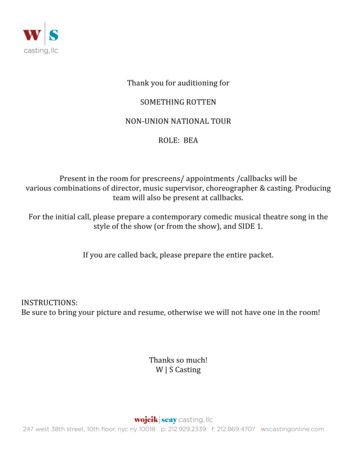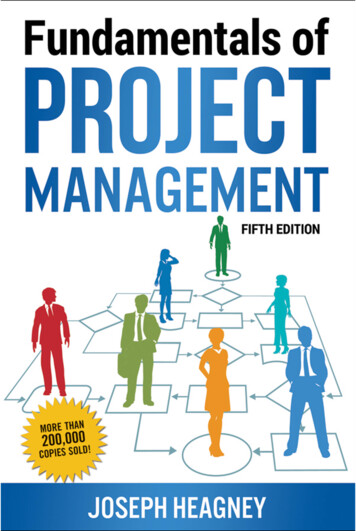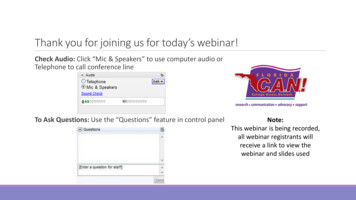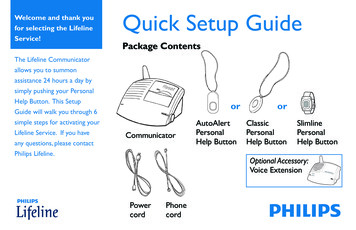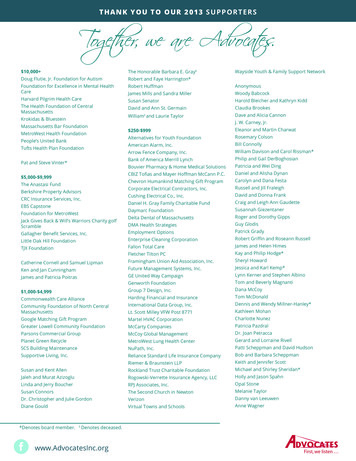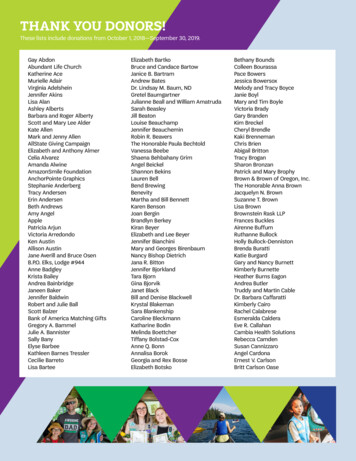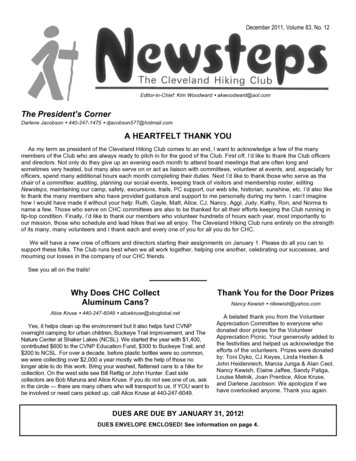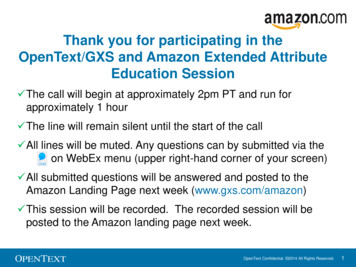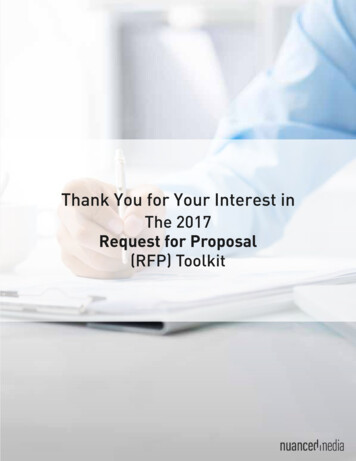
Transcription
Thank You for Your Interest inThe 2017Request for Proposal(RFP) Toolkit
A Letter from the CEOHi, this is Ryan Flannagan, founder and CEO of Nuanced Media. I want to thank you fordownloading the RFP Toolkit. My team and I created the RFP Toolkit because we know writing awebsite RFP can be a difficult and frustrating process. Throughout our years in business, we’vewritten and reviewed hundreds of RFPs, seen all the mistakes and missed opportunities. Fromthese, and other experiences, we’ve discovered all the breakthrough strategies.Website design is very different than other industries, so a general RFP just won’t cut it. Mostpeople’s knowledge about website design only scratches the surface, and many think it’s a fairlysimple process that only includes a handful of products and services. But the web design industryis growing rapidly, constantly adding new services and strategies to help companies like yoursreach your target market.If you ask for only the bare minimum in your RFP, you may miss some golden opportunities to growyour business. No need to worry: The Nuanced Media team created an RFP Toolkit that gives youall the tools you need to find the ideal website design partner for your project. When you includeour suggestions in your RFP, you’ll have a clear path of communication with your agency to getexactly what you want, maximizing your project goals and your results.Included in your Nuanced Media RFP Toolkit you will find an RFP Content Checklist and WebDesign Glossary. You’ll have everything you need to communicate your project needs clearly withindustry words and phrases.We wish you the best in your upcoming RFP process and remind you that Nuanced Media is at yourservice if you have any questions!Cheers,Ryan Flannagan, MBAFounder and CEO Nuanced Media
CONTENTWhy You Need an RFP2Your RFP Process3Checklist9Glossary12About
Why YouNeed an RFPAlthough people argue against RFPs, especially for web design,sometimes there is no way around them. If you are or work for anorganization that requires a bidding process, you will need an RFP.These include non-profits, governmental agencies, schools and verylarge companies with cost control policies in place. You might alsoconsider an RFP if you know your project will be large,time-consuming and costly. If you need an RFP, you have to do it right.RFPs provide very tight guidelines for projects, and hold all partiesinvolved accountable. This all helps to insure your goals are met tothe best of everyone’s abilities and allows you and your company anaccurate assessment of your needs.RFP Toolkit 2
Your RFPProcess1. Identify your boundaries, stakeholders, needs and schedule2. Write the RFP3. Review RFP and develop your scoring criteria for the proposalsa. You may score items on a 1-5 or a 1-10 scale, but someitems might hold more weight - depending on your project.Is it important your agency have close proximity to yourbusiness, or experience, do you want a lot of positivereviews, or are you very strict about your budget?4. Send it outa. Send via email to agencies around your area, or nationally.There are also business portals, and RFP sites likehttp://www.rfpdb.com/ that allow you to post your RFP for avariety of available venders5. Review and Researcha. Stay within your schedule6. Score each proposal based on your criteria7. Choose your agency and signRFP Toolkit 3
ChecklistIntroductionState the purpose of the RFP and make sure you send out a call forbids to fully (or partially) redesign (or update) your website; Detail the current status of your website as it relates to styleand function. Include where you host your website; Identify 3 to 4 overall qualities of your preferred websitedesigner candidate; Include a brief description of how the candidates will beevaluated. Include a detailed list later, we will guide youthrough it.Background About (Company/Organization)– Provide the background of your organization and includeyour company’s mission, goals, key staff bios andimportant industry accomplishments as well as yourcompany’s scope of work. Your website should reflectyour brand, core values and company culture. Project Background– Discuss your reasons for looking for a websitedesign/update;– Give a brief summary of the desired major changes fromyour current website. You will discuss the smaller, moredetailed changes later.Overview Project Goals (Scope of Work)– Provide a description of your project size and the numberand type of site pages;– Identify whether you are looking for custom developmentor a pre-developed theme.RFP Toolkit 4
Timeframe and Budget– Give a desired timeframe to complete the project and alaunch date for the new website. Remember, websitestake a lot longer to build than most people think. Giveyourself plenty of time for review, feedback, adjustmentsand dependencies;– Budget—Set the expectation for your desired budgetrange for your website redesign. Make sure to includesite maintenance, hosting, staff training, plug-ins,software integrations and any other expenses that mightbe included in the process.Check it out!Unlock the hidden information. Get your RFP Toolkit today!email@nuancedmedia.com520.555.1234Usage Current Usage/Website Statistics– Detail how visitors currently use your website;– Provide any important statistics about the website use.Examples: high volume, concurrent usage,multinational/linguistic usersRFP Toolkit 5
Required Elements– Compile a list of your expected final deliverables,including the required sections of the website and theirfunctionality;– Outline the required elements of your new website.Examples: site/web search function, e-commerce, videofunctionality, blog features, social media integration,login/account capabilities;– Detail any technological specifications for the project.Include specific programming language requirements,such as PHP or Javascript, and include your ContentManagement System requirements: Types of Content Management Systems· Open Sourced CMS: A system used to managethe content of a website that is available to allfor use, copy, edit, and redistribute. Wordpressis most common, representing 23.2% of allwebsites. However, Joomla and Drupal, with 3%and 1.9% of the website market share, also existas open sourced content management systems;· Proprietary CMS: A system used to managethe content of a website that is built on a codeowned privately, so that only the owner of thecode can maintain and distribute it. ProprietaryCMS’s typically fall into one of three categories:budget solution, low competition or verticalspecific. Some proprietary CMS examples areSquarespace 0.5%, SimpleView, Weebly 0.4%,Blackbaud and Wix 0.3%: Budget Solution/Low Competition: Thebudget solution or low competitionbusiness owner is looking for more of abillboard than a website;RFP Toolkit 6
Vertical Specific: There are many designagencies which have aligned themselveswith a particular industry vertical;· Built from scratch systems represent the other62% of websites on the internet. These systemsrange from custom HTML-only websites built byhigh school students, to very complex systemsbuilt by financial giants;– Outline any page security certificates or encryptioncapabilities necessary, such as SSL, form validations,database security and protocols. Include email hostingrequirements (client-based or local hosting);– Specify that you wish to own the website code. Target Audiences– Provide a list of the target markets that will use your siteincluding customer demographics and technologyprofiles, clients, sponsors, partners, investors, press andemployees;– Give a description of how each of these audiences willuse or interact with your website.Check it out!Unlock the hidden information. Get your RFP Toolkit today!email@nuancedmedia.com520.555.1234RFP Toolkit 7
Technological Infrastructure Servers/Hosting– Explain your current hosting environment;– Identify any changes you wish to make to your hostingservices. Third Party Sites– List any external websites that need integrating into yournew website and describe their purpose. Examples:e-commerce, reservation services, customer supportticketing, inventory, sales CRM etc. Search Engine Optimization (SEO)– Outline the level of SEO required within the scope of yourwebsite design. Traffic Reporting– Define any current analytics packages you have, describeany required changes necessary, and give new analytictools that you would like to integrate into your newwebsite.Design Style– Provide a brief description of the look and feel you wantto accomplish with your website design. Include someexamples of websites that reflect your desired designand functionality;– Identify whether you wish to use your current logo andbranding, or if you would like to update those elementsas well.Content Explain who will be responsible for content creation on thenew site.RFP Toolkit 8
Check it out! Identify whether the copy will come directly from the old site,or if you will need new content;– Outline who will write the website copy if you need newcontent. Will you need the web design company to createit or will your company provide new content? Specify if the website design company is responsible forfuture content changes or if your company will implementthe content changes. Outline where photos will be sourced, and whether you mustpurchase, edit or optimize the photos for web and mobileuseage.Unlock the hidden information. Get your RFP Toolkit today!email@nuancedmedia.com520.555.1234Proposal Deliverables Request for bidders to include the following in theirproposals:– Contact information (phone number, email address);– A summary of website development experience;RFP Toolkit 9
– A list of existing client references;– Their Project Plan, including phases for creation andimplementation;– The estimated Project Budget;– Details about website design process - design, discovery,quality assurance testing, and implementation;– Details regarding your company’s website projectmanagement structure;– Identify the project team members, including theirrelevant experience and credentials;– Any training options the bidder provides;– Contact information for clarification of the proposal, ifneeded. Evaluation Criteria– Identify evaluation criteria for the website designcandidates.Examples: pricing, meets requirements, experience, etc. Additional Information or Clarification– Use this section to add any information you need toinclude, not listed in any other section.Additional Considerations Value added– When considering agencies, keep in mind the valueadded; Does this agency offer marketing solutions or SEOtraining with your website? Will they work with you to improve your CTR or justfocus on design? These are things to be mindful of and open to, butyou might have to pay for this level of expertise. Make sure it’s edited and polished.RFP Toolkit 10
Optional ADA Compliance– Describe what level of ADA compliance you require. Conditions of Work– Identify any governmental regulations or requirements.These may range from HIPAA compliance to PCIcompliance, data encryption or SEC restrictions on datapresented. Functional Specification– This is an optional document that gives specificinstructions to developers for your website. This will gofurther in depth about the actual functionality of the siteand the specifications. This document is best suited forlarge and/or resource heavy projects.RFP Toolkit 11
GlossaryAPI (Application Programming Interfaces)A method that describes when a programmer writing an applicationprogram makes requests for (use of info from) a computer, operatingsystem, or another application.BrowserAn application program that provides a way to look at and interact withall the information on the internet. Examples: Firefox, Google Chrome,Safari.CMS (Content Management System)A system used to manage the content of a website. A CMS allows thecontent manager or author, who may not know Hypertext MarkupLanguage (HTML), to manage the creation, modification, and removalof content from a website without needing the expertise of aWebmaster.Cross Browser Compatibility (Browser Agnostic)The process of ensuring that a website is coded in such a way that it isdisplayed correctly across multiple browsers.CSS (Cascading Style Sheet)Code used to format the layout of Web pages by defining how todisplay HTML elements, such as headers and links. These style sheetscan then be applied to any Web Page.EncryptionEncryption is the process of encoding messages or information insuch a way that only authorized parties can read it.E-CommerceThe buying and selling of products and services by businesses andconsumers through an electronic medium, without using any paperdocuments. E-commerce is subdivided into three categories: businessto business or B2B (Cisco), business to consumer or B2C (Amazon),and consumer to consumer or C2C (eBay).RFP Toolkit 12
Framework (Web Development Framework)A set of resources and tools for software developers to build andmanage web applications, web services, and websites. A frameworkincludes templating capabilities within a browser, the programmingenvironment for scripting the flow of information, and the applicationprogramming interfaces (APIs) for accessing underlying dataresources.FTP (File Transfer Protocol)An internet protocol that allows a computer to send files to or receivefiles from another computer. Like many Internet resources, FTP worksby means of a client-server architecture; the user runs client softwareto connect to a server on the Internet.Hosting/Hosting ServiceHosting is an arrangement in which a web host (often an internetservice provider) maintains clients’ websites on its computers andprovides related services. These services may include leasing of harddisk space, maintenance of hardware and software, provision ofbackup and security, content integrity, credit card processing, emailboxes and high-speed internet connection.HTML (Hypertext Markup Language)The set of markup symbols or codes inserted in a file intended fordisplay on a World Wide Web browser page. This tells the Web browserhow to display a Web page’s words and images for the user.ISP (Internet Service Provider)An ISP is an organization that provides services and infrastructure foraccessing the Internet. Those services may include Internet access,domain name registration, Web hosting, and more.Permalink StructureA permanent link (permalink) is a URL that always points to anddirects readers to the same web page, blog post or any online digitalmedia.PlatformAny base of technologies on which other technologies or processesare built. An application can be a platform if it is a base for otherprograms.RFP Toolkit 13
Responsive (Web Design)Formatting a website design so that the Website automatically adjustsitself most for the optimal for viewing and navigation across a widerange of devices, including traditional PCs, smartphones and tabletdevices.SEO (Search Engine Optimization)Search Engine Optimization (SEO) is the process of affecting thevisibility of a website or web page in a search engine’s “natural” orun-paid (“organic”) search results.SitemapA list of pages of a website that are accessible to users. It can beeither a document in any form used as a planning tool for web design,or a Web page that lists the pages on a website, typically organized inhierarchical fashion.ThemeA template designed specifically for use to enhance the visualappearance and usability of a website. Many web developmentproviders offer a selection of themes for their clients to choose fromfor their sites. Alternatively, predesigned blog themes can be foundthrough a variety of websites, and many web designers offer customthemes for sites.TemplateA website template is a pre-designed web page, or set of web pages,that anyone can modify with their own content and images to set up awebsite.UI (User Interface)The junction between a user and a computer program. An interfacecommands or guides the way in which a user communicates with aprogram.WordpressAn example of a Content Management System.RFP Toolkit 14
database security and protocols. Include email hosting requirements (client-based or local hosting); – Specify that you wish to own the website code. Target Audiences – Provide a list of the target markets that will use your site including customer demographics and technology profiles, clients, sponsors, partners, investors, press and .
